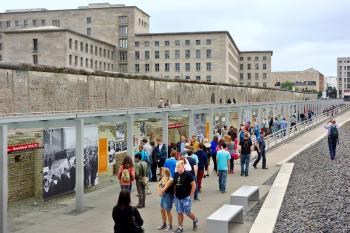Pomp and consequence: Visiting 20th-century fascist sites
Appears in the Online Edition, September 2018.
The sweeping impact of fascism in the 20th century can be felt to this day in the many monuments and memorials across Europe that remind us of those horrific years.
You can trace fascism's roots to the turbulent aftermath of World War I, where masses of angry people rose up, and their charismatic leaders manipulated that anger. Both Benito Mussolini in Italy and Adolf Hitler in Germany turned fringe movements claiming to be the champion of the oppressed into totalitarian fascist regimes.
Mussolini was the first, ruling with dictatorial power and -- for a time -- success. He pumped up the economy, created jobs and invested in infrastructure.
Two examples of that infrastructure that you can see today in Rome are the Olympic Stadium north of Vatican City, and the sterile planned city called E.U.R. in south Rome.
Part of a sports complex originally named Foro Mussolini, the Olympic Stadium (still in use today) was built with the stated intention of promoting Rome as a site for a future Olympic Games. But it was also built to promote physical prowess as a key element of fascist ideology. Athletes represented the "new fascist man": willing to believe, obey and fight. You can see this in the 18 imposing statues of hulking men that circle the track outside and the propaganda messages in the mosaics that pave the stadium's entry.
In the late 1930s, Mussolini made plans for an international exhibition -- the Exhibit Universal Rome (E.U.R.) -- to show off the wonders of his fascist society. While World War II stopped the fascist exhibition, the megaproject was completed in the 1950s. Today it houses apartment blocks, corporate and government offices and big, rarely visited museums.
Despite its grim past, E.U.R. (a 10-minute Metro ride from central Rome) is now an upscale district with a mix of businessmen and women at work -- and young people enjoying its trendy cafés. Because a few landmark buildings of Italian modernism are located here, E.U.R. is an important destination for architecture buffs. Hiking down the wide, pedestrian-mean boulevards, you'll see patriotic murals and stern squares decorating the sterile office blocks, and patriotic quotes chiseled into walls. The uniform buildings and rigid grid-plan streets were meant to celebrate order and conformity, while echoing a powerful past and promising a glorious future. These buildings were also meant to intimidate -- to make the average person feel small and powerless.
Inspired by Mussolini and buoyed by the Great Depression in 1929, Hitler's similar promises of a better life gained traction in Germany. For the Nazis, the city that most embodied their sense of national unity was Nürnberg. Nicknamed the "most German of German cities," it was a favorite of Hitler's to showcase his nationalistic pomp and pageantry, and it's with grand rallies held here that he inspired Germans to get on board.
Within the Rally Grounds, a 4-square-mile area a 10-minute tram ride southeast of Nürnberg's Old Town, Hitler made Zeppelin Field the site of his enormous rallies. Today, the stark remains of this massive gathering place are thought-provoking. Also part of this complex -- looming over a now peaceful lake -- is his huge-yet-unfinished Congress Hall, which now houses the excellent Documentation Center museum. The largest surviving example of Nazi architecture, Hitler modeled this building after the Roman Colosseum ... but even more colossal. The Documentation Center meticulously traces the evolution of the National Socialist movement, focusing on how it both energized and terrified the German people.
Another stage set for this propaganda show was Hitler's mountain-capping Eagle's Nest. This alpine getaway, south of Munich in Berchtesgaden, was used to soften Hitler's image. A stone tunnel crafted with fascist precision leads to Hitler's plush elevator, which whisks visitors to the top today.
Berlin is full of sights that let us reflect on these dark times: the Germany History Museum and its powerful propaganda art display; the Reichstag parliament building, which caught fire under mysterious circumstances in 1933, giving Hitler an excuse to frame the communists and grab power for himself; and the Topography of Terror exhibit, which stands on the rubble of what was once the most feared address in the city -- the headquarters of the Gestapo secret police and the elite SS force.
Hitler's life would end in Berlin, deep underground in a bunker with his capital smoldering in ruins. Finally, in the spring of 1945, the war in Europe ended. But the aftermath will always linger in the minds of those who live in its wake and those who visit.
While traveling in Italy and Germany recently and taking in these remnants of Mussolini and Hitler's reigns, I was struck by how entire nations have become mesmerized and led astray by fascist leaders. The best souvenir from that trip: a realization of how fragile democracy is -- and how, if you take freedom for granted, you can lose it.
(Rick Steves (www.ricksteves.com) writes European travel guidebooks and hosts travel shows on public television and public radio. Email him at rick@ricksteves.com and follow his blog on Facebook.)


